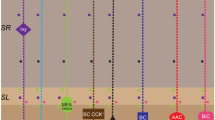Summary
Following brief ischemia, the Mongolian gerbil is reported to develop unusual hippocampal cell injury (Brain Res 239:57–69, 1982). To further clarify this hippocampal vulnerability, gerbils were subjected to ischemia for 3, 5, 10, 20, and 30 min by bilateral occlusion of the common carotid arteries. They were perfusion-fixed after varying intervals of survival time ranging from 3 h up to 7 days. Following brief ischemia (5–10min), about 90% of the animals developed typical hippocampal damage. The lesion was present throughout the extent of the dorsal hippocampus, whereas damage outside the hippocampus was not observed. Each sector of the hippocampus showed different types of cell reaction to ischemia. Ischemic cell change was seen in scattered CA4 neurons, and reactive change was found in CA2, whereas CA1 pyramidal cells developed a strikingly slow cell death process. Ischemia for 3 min did not produce hippocampal lesion in most cases. Following prolonged ischemia (20–30min), brain injury had a wide variety in its extent and distribution. These results revealed that the gerbil brief ischemia model can serve as an excellent, reliable model to study the long-known hippocampal selective vulnerability to ischemia. Delayed neuronal death in CA1 pyramidal cells was confirmed after varying degrees of ischemic insult. These findings demonstrated that the pathology of neuronal injury following brief ischemia was by no means uniform nor simple.
Similar content being viewed by others
References
Arai H, Lust WD, Passonneau JV (1982) Delayed metabolic changes induced by 5 min of ischemia in gerbil brain. Trans Am Soc Neurochem 13:177
Brierley JB (1976) Cerebral hypoxia. In: Blackwood W, Corsellis JAN (eds) Greenfield's neuropathology, 3rd edn. Arnold, London, pp 41–85
Brown AW, Brierley JB (1972) Anoxic-ischemia cell change in rat brain, light microscopic and fine-structural observations. J Neurol Sci 16:59–84
Brown AW, Levy DE, Kublik M, Harrow J, Plum F, Brierley JB (1979) Selective chromatolysis of neurons in the gerbil brain: A possible consequence of “epileptic” activity produced by common carotid artery occlusion. Ann Neurol 5:127–138
Bubis JJ, Fujimoto T, Ito U, Mrsulja BJ, Spatz M, Klatzo I (1976) Experimental cerebral ischemia in Mongolian gerbils. V. Ultrastructural changes in H3 sector of the hippocampus. Acta Neuropathol (Berl) 36:285–294
Cohn R (1979) Convulsive activity in gerbils subjected to cerebral ischemia. Exp Neurol 65:391–397
Crockard A, Iannotti F, Hunstock AT, Smith RD, Harris RJ, Symon L (1980) Cerebral blood flow and edema following carotid occlusion in the gerbil. Stroke 11:494–498
Diemer NH, Siemkowicz E (1980) Increased 2-deoxyglucose uptake in hippocampus, globus pallidus and substantia nigra after cerebral ischemia. Acta Neurol Scand 61:56–63
Glickman SE, Higgins TJ, Isaacson RL (1970) Some effects of hippocampal lesion on the behavior of Mongolian gerbils. Physiol Behav 5:931–938
Isaacson RL, Pribram KH (eds) (1975) The hippocampus: A comprehensive treatise, vols 1 and 2, Plenum Press, New York
Isaacson RL (1982) The limbic system, 2nd edn. Plenum Press, New York London
Ito U, Spatz M, Walker JT Jr, Klatzo I (1975) Experimental cerebral ischemia in Mongolian gerbils. I. Light-microscopic observations. Acta Neuropathol (Berl) 32:209–223
Jenkins LW, Povlishock JT, Lewelt W, Miller JD, Becker DP (1981) The role of postischemic recirculation in the development of ischemic neuronal injury following complete cerebral ischemia. Acta Neuropathol (Berl) 55:205–220
Kahn K (1972) The natural course of experimental cerebral infarction in the gerbil. Neurology (Minneap) 22:510–515
Kirino T, Sano K (1980) Changes in the contralateral dentate gyrus in Mongolian gerbils subjected to unilateral cerebral ischemia. Acta Neuropathol (Berl) 50:121–129
Kirino T (1982) Delayed neuronal death in the gerbil hippocampus following ischemia. Brain Res 239:59–69
Kirino T, Sano K (1984) Fine structural nature of delayed neuronal death following ischemia in the gerbil hippocampus. Acta Neuropathol (Berl) 62:209–218
Levine S, Payan H (1966) Effects of ischemia and other procedures on the brain and retina of the gerbil (Meriones unguiculatus). Exp Neurol 16:255–262
Levy DE, Brierley JB, Plum F (1975) Ischaemic brain damage in the gerbil in the absence of ‘no-reflow’. J Neurol Neurosurg Psychiatry 38:1197–1205
Levy DE, Van Ultert RL, Pike CL (1979) Delayed postischemic hypoperfusion: a potentially damaging consequence of stroke. Neurology (NY) 29:1245–1252
Loskota WJ, Lomax P, Verity MA (1974) A stereotaxic atlas of the Mongolian gerbil brain (Meriones unguiculotus). Ann Arbor Science. Ann Arbor
McGee-Russel SM, Brown AW, Brierley JP (1970) A combined light and electron microscope study of early anoxic ischaemic cell change in rat brain. Brain Res 20:193–200
Pulsinelli WA, Brierley JB (1979) A new model of bilateral hernispneric ischemia in the unanesthetized rat. Stroke 10:267–272
Pulsinelli WA, Brierley JB, Plum F (1982a) Temporal profile of neuronal damage in a model of transient forebrain ischemia. Ann Neurol 11:491–498
Pulsinelli WA, Levy DE, Duffy TE (1982b) Regional cerebral blood flow and glucose metabolism following transient forebrain ischemia. Ann Neurol 11:499–509
Pulsinelli WA, Duffy TE (1982) Temporal profile of regional high-energy metabolites in rat brain after transient forebrain ischemia. Abstr Soc Neurosci 8:1004
Shepherd GM (1979) The synaptic organization of the brain, 2nd edn. Oxford University Press, New York Oxford
Scholz W (1959) The contribution of pathoanatomical research to the problem of epilepsy. Epilepsia 1:36–55
Suzuki R, Yamaguchi T, Li CL, Klatzo I (1983) The effects of 5-minute ischemia in Mongolian gerbils. II. Changes of spontaneous neuronal activity in cerebral cortex and CA1 sector of hippocampus. Acta Neuropathol (Berl) 60:217–222
Trump BF, McDowell EM, Arstila AU (1980) Cellular reaction to injury. In: Hill RB, LaVia MF (eds) Principles of pathology, 3rd edn. Oxford University Press, New York Oxford, pp 20–111
Walters GC, Pearl J, Rogers JV (1963) The gerbil as a subject in behavioral research. Psychol Rep 12:315–318
Author information
Authors and Affiliations
Rights and permissions
About this article
Cite this article
Kirino, T., Sano, K. Selective vulnerability in the gerbil hippocampus following transient ischemia. Acta Neuropathol 62, 201–208 (1984). https://doi.org/10.1007/BF00691853
Received:
Accepted:
Issue Date:
DOI: https://doi.org/10.1007/BF00691853




